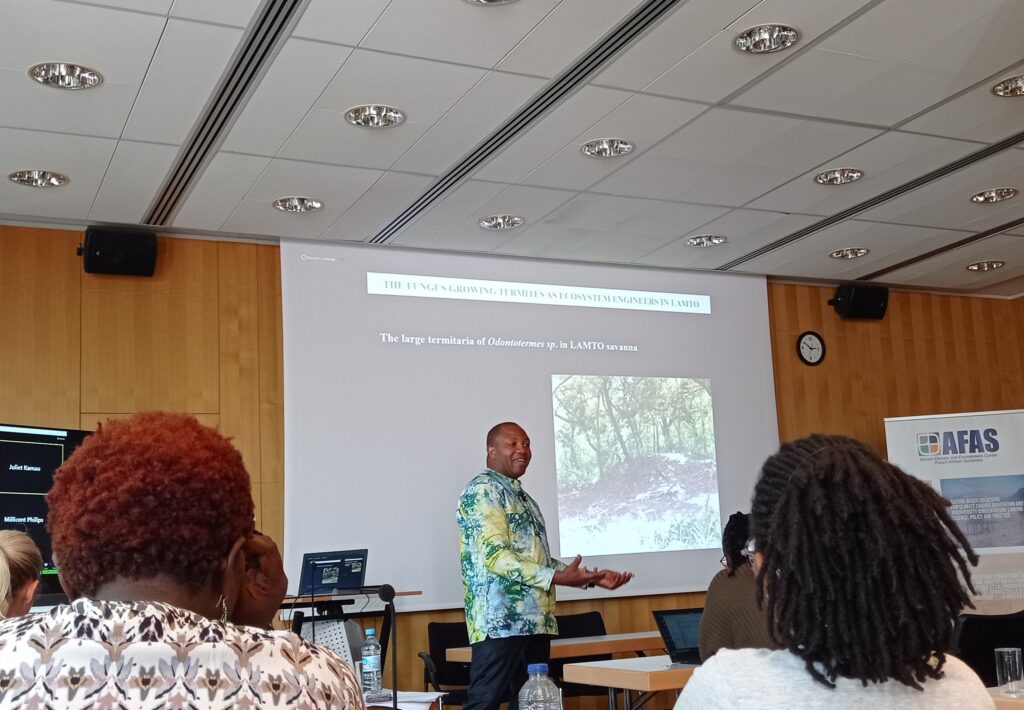
Termites are small “soft-bodied eusocial ‘white ants’ insects” which feed on a variety of organic material, ranging from leaf litter, wood or soil humus. Their feeding character has made various people to perceive them differently. For instance, across agricultural landscapes, termites (together with earthworms) have been regarded as crucial sources of proteins, vitamins, fats, carbohydrates and minerals to poultry due to their high nutritional value (Tiroesele and Moreki, 2012). In contrast, other people regard termites as pests, owing to their destructive nature to farm produce resulting to low crop yields and huge losses to farmers. As a mitigation measure, the farmers have adopted various physical and chemical measures to manage them. The attribute of termites wreaking havoc to farmers was well known to the AFAS students mainly because a majority of them hail from agricultural backgrounds in Africa as they have witnessed first-hand their negative impact. The termites are also known to damage wooden building structures by feeding on them. What was interesting to note is that only about 1% of the over 2000 different species of termites can be regarded to as pests. The remaining 99% of termite species offer beneficial services to the ecosystem, such as soil nitrogen fixation, decomposition of dead organic matter, establishment of new microhabitats and enhancement of soil hydrology characteristics through creation of underground channels and through which rainwater easily infiltrates (Silue et al. 2022; Ozsahin et.al 2022; Korb et.al 2019). In the process, the termites alter both chemical and physical composition of the soil, boost soil aeration during their feeding and nesting activities, as well as enhance soil water absorption and storage. Plant performance can be significantly impacted by interactions between species, both above- and below-ground. Termite nests add substrate heterogeneity to many dry habitats by changing the characteristics of the soil, and this promotes plant development. This has resulted in ecologists terming termites as ‘ecological engineers’ owing to that pivotal role in shaping ecological habitats where they inhabit, a widespread phenomenon highly evident across the African Savannas.
The International Union for Conservation of Nature (IUCN, 2016) categorizes ecological engineering as an ecosystem restoration approach embedded in the larger nature-based solutions fraternity, which mainly involves designing sustainable ecosystems by integrating human society with natural environment for the benefit of both. The human society has successfully harnessed the ecosystem services provided by termites for soil rehabilitation and management of agroecosystems, an example being through a revolutionary farming technique known as the Zai System for savanna restoration. Under the Zai System, the termites are attracted to a degraded landscape, for instance a savanna and through their action, soil fertility, plant growth and humidity in that landscape is enhanced. Practically, the presence of termites has been attributed to a 36% increase in crop yields across semi-arid areas (Korb et.al 2019), thus contributing effectively to United Nation’s Sustainable Development Goal 2 on Zero Hunger. In addition, the communities’ resilience to climate induced shocks such as droughts is increased while at the same time curbing desertification. Currently, there is wide adoption of the Zai System in West African savannas though the system is also being increasingly adopted by other African countries such as Kenya. This technique was pioneered in a fragile West African Savanna ecosystem by a Burkinabe farmer, Mr Yacouba Sawadogo, and who in 2018 was awarded the Right Livelihood Award for his active engagement in applying and improving the Zaï System. It was interesting to note that Prof Souleymane Konate worked closely with Mr Yacouba Sawadogo in the mid-1980s in developing this revolutionary practice. The success of such technique is clear evidence of the power of harnessing nature to address societal challenges, a signal towards the adoption of nature-based solutions across various facets of human development.
Knowledge unimplemented is known to leave potential undercapitalized. The AFAS students promised to leverage on this knowledge to advocate on better ways which the farming community can upscale. This includes approaches such as harnessing the power of termites as ecological engineers to enhance food security in their regions and curb desertification. Indeed, nature has solutions to societal problems, a supportive hack to promote and upscale various nature-based solutions within our societies. There is also a need to place ecological engineers (termites) on an equal footing with other well-known engineers such as mechanical engineers, electrical engineers, electronic engineers, etc. to recognize the salutary role they play in sustaining livelihoods and shaping agroecosystems. We need to salute the termites. Shall we?
Bibliography
Information about the authors:
Joseph N. Ndiba is an AFAS fellow from the 1st MSc cohort based at the University of Nairobi in Kenya.
(juniorndiba[at]gmail.com/ ndibajoseph[at]students.uonbi.ac.ke)
Grace W. Kamau is an AFAS fellow from the 1st MSc cohort based at the University of Nairobi in Kenya.
(gracekamau030[at]gmail.com/ gkamau[at]students.uonbi.ac.ke)
Anita Myriam Emma Kouassi is an AFAS fellow from the 1st MSc cohort based at the Université Félix Houphouët-Boigny in Côte d’Ivoire.
(emmyklord[at]gmail.com)